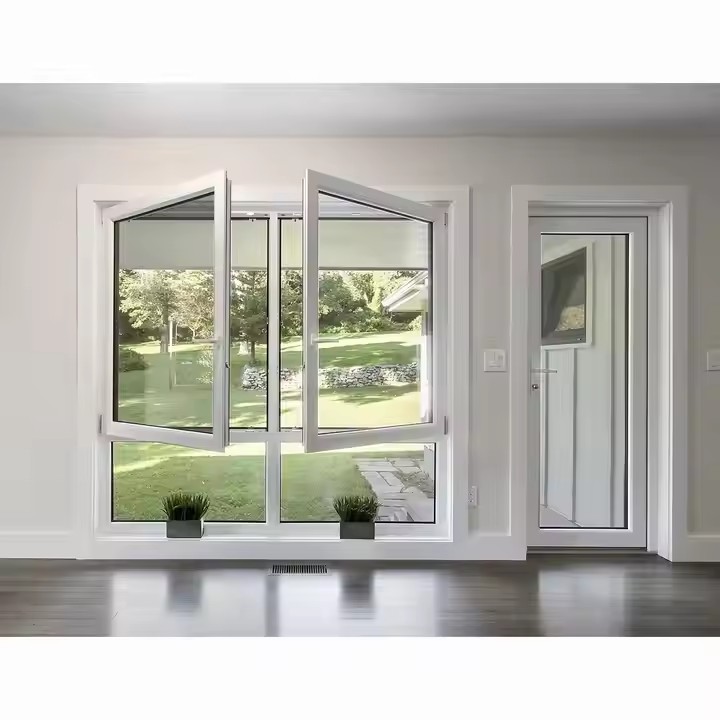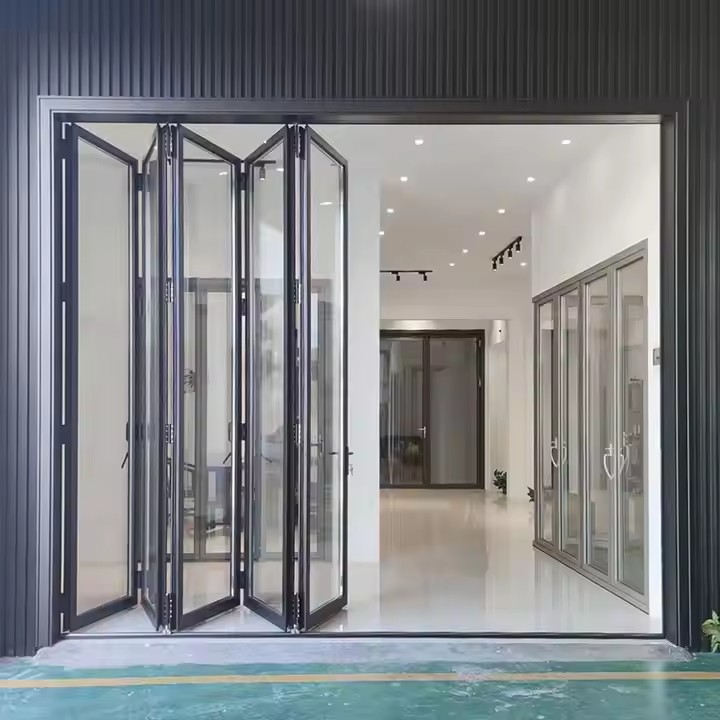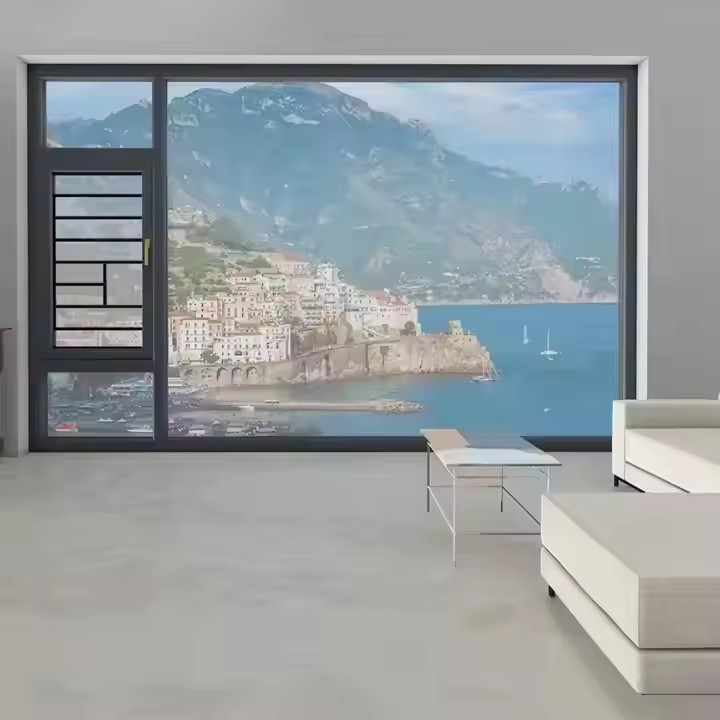Opening Method and Angle
Opening Method: There are several opening methods for casement windows, such as top-hung, bottom-hung, and center-hung. Top-hung windows have good rainproof performance. When ventilating, they can prevent rainwater from entering the room, which is suitable for areas with high waterproof requirements like bathrooms and kitchens. Bottom-hung windows have good ventilation effects, but their rainproof performance is relatively weak, and they are often used in positions where there is a high demand for ventilation and are not easily exposed to rain. Center-hung windows combine the advantages of both, with a larger opening angle, providing better ventilation and lighting effects, and are commonly used for the high side windows of industrial workshops or large public buildings. The opening method should be reasonable, as it needs to be analyzed according to the specific size and height of the house.
Material Selection
Window Frame Material: Common window frame materials include aluminum alloy, broken bridge aluminum, plastic steel, and wood. Aluminum alloy window frames have the advantages of high strength, corrosion resistance, and light weight, with a simple and modern appearance, suitable for various architectural styles. Broken bridge aluminum window frames add an insulating broken bridge structure on the basis of aluminum alloy, having good heat insulation and sound insulation performance, and are commonly used in medium and high-end buildings. Plastic steel window frames have excellent thermal insulation, sound insulation, and sealing performance, and are relatively low in price, but their appearance texture is slightly inferior to that of aluminum alloy and broken bridge aluminum. Wooden window frames give a natural and warm feeling, with good thermal insulation performance, suitable for architectural styles such as Chinese style and Japanese style, but attention should be paid to moisture prevention and maintenance. It is better to choose materials of good quality, which can extend the service life.

Glass Material: The choice of glass directly affects the lighting, heat insulation, sound insulation, and safety performance of the casement window. Ordinary transparent glass has good lighting performance, but its heat insulation and sound insulation effects are average. Double or multi-layer insulating glass has an air layer or inert gas layer in the middle, which can effectively improve the heat insulation and sound insulation performance, and is a commonly used type of glass at present. If there is a high requirement for safety performance, laminated glass or tempered glass can be selected. Laminated glass will not scatter and hurt people when it is broken, and tempered glass has high strength and good impact resistance. In addition, glass with special functions, such as coated glass and Low-E glass, can also be selected according to needs to further improve the energy-saving effect of the window.
Hardware Accessories
Hinges or Butts: The hinges or butts of casement windows need to bear the weight of the window and ensure smooth opening and closing. Therefore, reliable products with strong load-bearing capacity should be selected. The materials of hinges are generally stainless steel, copper, etc. Stainless steel hinges have good corrosion resistance and strength, and are a common choice. Both hinges and butts are crucial parts in the invisible areas, so it is necessary to choose those of relatively good quality as much as possible.
Handles: The design of the handle should take into account the convenience and comfort of use, and also match the overall style of the window. Common handles include 平开式 (side-hung type) and folding type, etc., and the materials include metal, plastic, wood, etc. Metal handles have a good texture and high strength; plastic handles are inexpensive and come in a variety of colors; wooden handles complement wooden window frames well, creating a warm atmosphere.
Limiters: Limiters can restrict the opening angle of the window to prevent potential safety hazards or damage caused by the window opening too wide. When designing, the position and angle of the limiter should be reasonably set according to the usage scenario and safety requirements of the window.
Waterproofing and Sealing
Waterproof Design: The waterproof performance of casement windows is crucial, especially for top-hung and center-hung windows. Waterproof sealant should be used to seal the connection between the window frame and the wall to prevent rainwater from seeping in. At the same time, the drainage system of the window also needs to be reasonably designed. Generally, drainage holes are set at the bottom of the window frame to discharge rainwater outside the window in a timely manner. The size and number of drainage holes should be determined according to the size of the window and the local rainfall.

Sealing Performance: Good sealing performance can improve the heat insulation and sound insulation effects of the window and reduce energy consumption. Sealing rubber strips should be installed around the window. The rubber strips should have good elasticity and aging resistance to ensure that the window fits tightly when closed without leaving gaps.
Safety Performance
Protective Measures: For high-rise residential buildings or families with children, necessary protective measures should be set for casement windows, such as installing protective railings or using safety glass. The height and spacing of the protective railings should comply with relevant safety standards. Generally, the height should not be lower than 1.1 meters, and the spacing should not be greater than 0.11 meters to prevent children from climbing or accidentally falling from the building.
Wind Resistance: In areas with strong winds, the design of casement windows should consider wind resistance. Select window frame materials and hardware accessories with high strength, and improve the wind resistance of the window through reasonable structural design, such as increasing the wall thickness of the window frame and strengthening the connection between the window and the wall, to ensure the safety of the window in strong wind weather.
Aesthetics and Overall Harmony

Appearance Design: The appearance of the casement window should be unified with the overall architectural style. This can be achieved through aspects such as the color, shape, lines of the window frame, and the decoration of the glass. For example, buildings in a modern and simple style are suitable for window frames with simple straight lines and transparent glass; buildings in a European style can choose window frames with decorative lines and patterns, matched with colored glass or artistic glass to increase the grandeur of the building.
Harmony with the Surrounding Environment: The design of the window also needs to consider harmony with the surrounding environment. For example, in places with beautiful natural landscapes, the design of the casement window can try to expand the lighting surface to introduce the outdoor scenery into the room. At the same time, the color and material of the window frame should also blend in with the surrounding natural environment to avoid a sense of abruptness.

